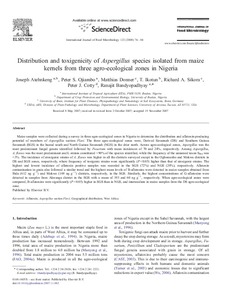| dc.contributor.author | Probst, C. |
| dc.contributor.author | Bandyopadhyay, Ranajit |
| dc.contributor.author | Cotty, P. |
| dc.date.accessioned | 2019-12-04T10:58:26Z |
| dc.date.available | 2019-12-04T10:58:26Z |
| dc.date.issued | 2014 |
| dc.identifier.citation | Probst, C., Bandyopadhyay, R. & Cotty, P. (2014). Diversity of aflatoxin-producing fungi and their impact on food safety in sub-Saharan Africa. International Journal of Food Microbiology, 174, 113-122. |
| dc.identifier.issn | 0168-1605 |
| dc.identifier.uri | https://hdl.handle.net/20.500.12478/990 |
| dc.description.abstract | Crops frequently contaminated by aflatoxins are important sources of revenue and daily nourishment in manyportions of sub-Saharan Africa. In recent years, reports have associated aflatoxinswith diminished human healthand export opportunities in many African Nations. Aflatoxins are highly carcinogenic metabolites mainly producedby members of Aspergillus sect. Flavi. The current study examined aflatoxin-producing fungi associatedwith maize grain intended for human consumption in 18 sub-Saharan African countries. 4469 Aspergillus sect.Flavi isolates were obtained from 339 samples. The majority (75%) of isolates belonged to the L strainmorphotype of A. flavus. Minor percentages were A. tamarii (6%), A. parasiticus (1%), and isolates with S strainmorphology (3%). No A. bombycis or A. nomius isolates were detected. Phylogenetic analyses of partial sequencesof the nitrate reductase gene (niaD, 1.3 kb) and the aflatoxin pathway transcription factor gene (aflR, 1.7 kb)were used to verify isolate assignments into species and lineages. Phylogenetics resolved S strain isolates producingonly B aflatoxins into two lineages fully supported by sizes of deletions in the gene region spanning the aflatoxinbiosynthesis genes cypA (aflU) and norB (aflF). One lineage was the A. flavus S strain with either 0.9 or1.5 kb deletions. The second lineage, recently described from Kenya, has a 2.2 kb deletion. Taxa with S strainmorphology differed in distribution with strain SBG limited toWest Africa and both A. minisclerotigenes and thenew lineage from Kenya in Central and East Africa. African A. flavus L strain isolates formed a single clade withL strain isolates from other continents. The sampled maize frequently tested positive for aflatoxins (65%),fumonisins (81%), and deoxynivalenol (40%) indicating the presence of fungi capable of producing the respectivetoxins. Percentage of samples exceeding US limits for total aflatoxins (regulatory limit), fumonisins (advisorylimit), and deoxynivalenol (advisory limit) were 47%, 49%, 4%, respectively. |
| dc.format.extent | 113-122 |
| dc.language.iso | en |
| dc.subject | Aspergillus Flavus |
| dc.subject | Maize |
| dc.subject | Aflatoxins |
| dc.subject | Mycotoxins |
| dc.subject | Food Security |
| dc.title | Diversity of aflatoxinproducing fungi and their impact on food safety in subSaharan Africa |
| dc.type | Journal Article |
| dc.description.version | Peer Review |
| cg.contributor.crp | Maize |
| cg.contributor.affiliation | University of Arizona |
| cg.contributor.affiliation | International Institute of Tropical Agriculture |
| cg.coverage.region | Africa South Of Sahara |
| cg.isijournal | ISI Journal |
| cg.authorship.types | CGIAR and advanced research institute |
| cg.iitasubject | Aflatoxin |
| cg.journal | International Journal of Food Microbiology |
| cg.howpublished | Formally Published |
| cg.accessibilitystatus | Limited Access |
| local.dspaceid | 77919 |
| cg.identifier.doi | https://dx.doi.org/10.1016/j.ijfoodmicro.2013.12.010 |

